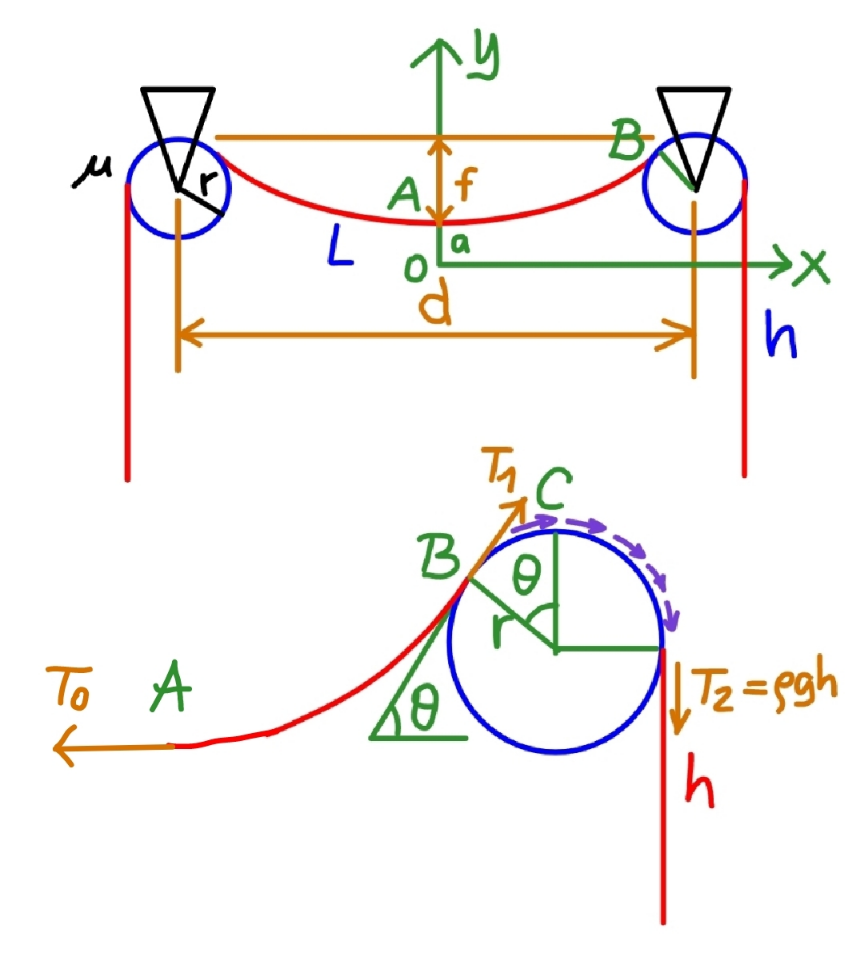
Question Number 187355 by mr W last updated on 16/Feb/23

Commented by mr W last updated on 17/Feb/23

$${find}\:{the}\:{maximum}\:{and}\:{minimum} \\ $$$${possible}\:{deflection}\:{in}\:{the}\:{middle} \\ $$$${of}\:{the}\:{uniform}\:{thin}\:{rope}\:{with}\:{length} \\ $$$${L}. \\ $$$${the}\:{friction}\:{coefficient}\:{between}\:{the} \\ $$$${rope}\:{and}\:{the}\:{fixed}\:{pulleys}\:{with}\: \\ $$$${radius}\:{r}\:{is}\:\mu. \\ $$
Commented by Humble last updated on 16/Feb/23

$${I}\:{look}\:{up}\:{to}\:{my}\:{superiors}\:\:{for}\:\:{the}\:{solution} \\ $$
Answered by mr W last updated on 19/Feb/23

Commented by mr W last updated on 19/Feb/23
![T_1 =T_2 e^(μ((π/2)+θ)) =ρghe^(μ((π/2)+θ)) T_0 =T_1 cos θ a=(T_0 /(ρg))=he^(μ((π/2)+θ)) cos θ x_B =(d/2)−r sin θ y_B =a+f−(1−cos θ)r s_(AB) =(L/2)−h−((π/2)+θ)r eqn. of catenary: y=a cosh (x/a) at point B: y_B =a cosh (((d/2)−r sin θ)/a)=a+f−(1−cos θ)r s=a sinh (((d/2)−r sin θ)/a)=(L/2)−h−((π/2)+θ)r tan θ=sinh (((d/2)−r sin θ)/a) tan θ=sinh (((d/2)−r sin θ)/(he^(μ((π/2)+θ)) cos θ)) ⇒h=(((d/2)−r sin θ)/([sinh^(−1) (tan θ)] e^(μ((π/2)+θ)) cos θ)) he^(μ((π/2)+θ)) cos θ tan θ=(L/2)−h−((π/2)+θ)r h[1+e^(μ((π/2)+θ)) sin θ]=(L/2)−((π/2)+θ)r ⇒h=((((L−πr)/2)−θr)/(1+e^(μ((π/2)+θ)) sin θ)) determinant (((((((L−πr)/2)−θr)/(1+e^(μ((π/2)+θ)) sin θ))=(((d/2)−r sin θ)/([sinh^(−1) (tan θ)] e^(μ((π/2)+θ)) cos θ))))) we get two solutions for 0<θ<(π/2). one for f_(max) and the other for f_(min) . f=a(cosh (((d/2)−r sin θ)/a)−1)+(1−cos θ)r determinant (((f=[((((L−πr)/2)−θr)/(e^(−μ((π/2)+θ)) +sin θ))+r](1−cos θ))))](Q187459.png)
$${T}_{\mathrm{1}} ={T}_{\mathrm{2}} {e}^{\mu\left(\frac{\pi}{\mathrm{2}}+\theta\right)} =\rho{ghe}^{\mu\left(\frac{\pi}{\mathrm{2}}+\theta\right)} \\ $$$${T}_{\mathrm{0}} ={T}_{\mathrm{1}} \mathrm{cos}\:\theta \\ $$$${a}=\frac{{T}_{\mathrm{0}} }{\rho{g}}={he}^{\mu\left(\frac{\pi}{\mathrm{2}}+\theta\right)} \mathrm{cos}\:\theta \\ $$$${x}_{{B}} =\frac{{d}}{\mathrm{2}}−{r}\:\mathrm{sin}\:\theta \\ $$$${y}_{{B}} ={a}+{f}−\left(\mathrm{1}−\mathrm{cos}\:\theta\right){r} \\ $$$${s}_{{AB}} =\frac{{L}}{\mathrm{2}}−{h}−\left(\frac{\pi}{\mathrm{2}}+\theta\right){r} \\ $$$${eqn}.\:{of}\:{catenary}: \\ $$$${y}={a}\:\mathrm{cosh}\:\frac{{x}}{{a}} \\ $$$${at}\:{point}\:{B}: \\ $$$${y}_{{B}} ={a}\:\mathrm{cosh}\:\frac{\frac{{d}}{\mathrm{2}}−{r}\:\mathrm{sin}\:\theta}{{a}}={a}+{f}−\left(\mathrm{1}−\mathrm{cos}\:\theta\right){r} \\ $$$${s}={a}\:\mathrm{sinh}\:\frac{\frac{{d}}{\mathrm{2}}−{r}\:\mathrm{sin}\:\theta}{{a}}=\frac{{L}}{\mathrm{2}}−{h}−\left(\frac{\pi}{\mathrm{2}}+\theta\right){r} \\ $$$$\mathrm{tan}\:\theta=\mathrm{sinh}\:\frac{\frac{{d}}{\mathrm{2}}−{r}\:\mathrm{sin}\:\theta}{{a}} \\ $$$$\mathrm{tan}\:\theta=\mathrm{sinh}\:\frac{\frac{{d}}{\mathrm{2}}−{r}\:\mathrm{sin}\:\theta}{{he}^{\mu\left(\frac{\pi}{\mathrm{2}}+\theta\right)} \mathrm{cos}\:\theta} \\ $$$$\Rightarrow{h}=\frac{\frac{{d}}{\mathrm{2}}−{r}\:\mathrm{sin}\:\theta}{\left[\mathrm{sinh}^{−\mathrm{1}} \:\left(\mathrm{tan}\:\theta\right)\right]\:{e}^{\mu\left(\frac{\pi}{\mathrm{2}}+\theta\right)} \mathrm{cos}\:\theta} \\ $$$${he}^{\mu\left(\frac{\pi}{\mathrm{2}}+\theta\right)} \mathrm{cos}\:\theta\:\mathrm{tan}\:\theta=\frac{{L}}{\mathrm{2}}−{h}−\left(\frac{\pi}{\mathrm{2}}+\theta\right){r} \\ $$$${h}\left[\mathrm{1}+{e}^{\mu\left(\frac{\pi}{\mathrm{2}}+\theta\right)} \mathrm{sin}\:\theta\right]=\frac{{L}}{\mathrm{2}}−\left(\frac{\pi}{\mathrm{2}}+\theta\right){r} \\ $$$$\Rightarrow{h}=\frac{\frac{{L}−\pi{r}}{\mathrm{2}}−\theta{r}}{\mathrm{1}+{e}^{\mu\left(\frac{\pi}{\mathrm{2}}+\theta\right)} \mathrm{sin}\:\theta} \\ $$$$\begin{array}{|c|}{\frac{\frac{{L}−\pi{r}}{\mathrm{2}}−\theta{r}}{\mathrm{1}+{e}^{\mu\left(\frac{\pi}{\mathrm{2}}+\theta\right)} \mathrm{sin}\:\theta}=\frac{\frac{{d}}{\mathrm{2}}−{r}\:\mathrm{sin}\:\theta}{\left[\mathrm{sinh}^{−\mathrm{1}} \:\left(\mathrm{tan}\:\theta\right)\right]\:{e}^{\mu\left(\frac{\pi}{\mathrm{2}}+\theta\right)} \mathrm{cos}\:\theta}}\\\hline\end{array} \\ $$$${we}\:{get}\:{two}\:{solutions}\:{for}\:\mathrm{0}<\theta<\frac{\pi}{\mathrm{2}}.\:{one} \\ $$$${for}\:{f}_{{max}} \:{and}\:{the}\:{other}\:{for}\:{f}_{{min}} . \\ $$$${f}={a}\left(\mathrm{cosh}\:\frac{\frac{{d}}{\mathrm{2}}−{r}\:\mathrm{sin}\:\theta}{{a}}−\mathrm{1}\right)+\left(\mathrm{1}−\mathrm{cos}\:\theta\right){r} \\ $$$$\begin{array}{|c|}{{f}=\left[\frac{\frac{{L}−\pi{r}}{\mathrm{2}}−\theta{r}}{{e}^{−\mu\left(\frac{\pi}{\mathrm{2}}+\theta\right)} +\mathrm{sin}\:\theta}+{r}\right]\left(\mathrm{1}−\mathrm{cos}\:\theta\right)}\\\hline\end{array} \\ $$
Commented by mr W last updated on 17/Feb/23

Commented by mr W last updated on 17/Feb/23

